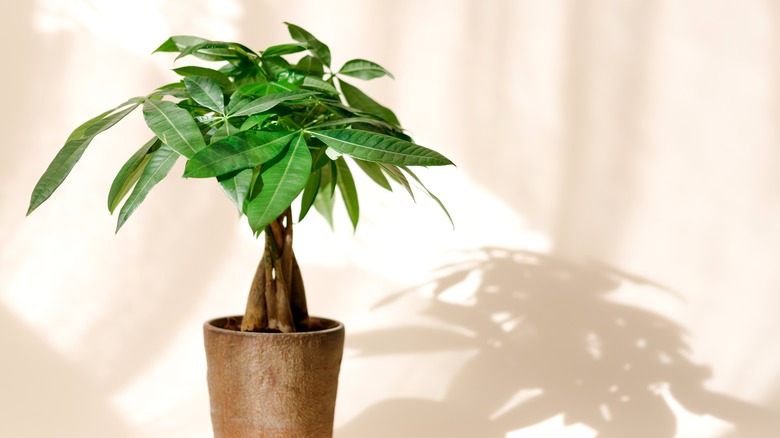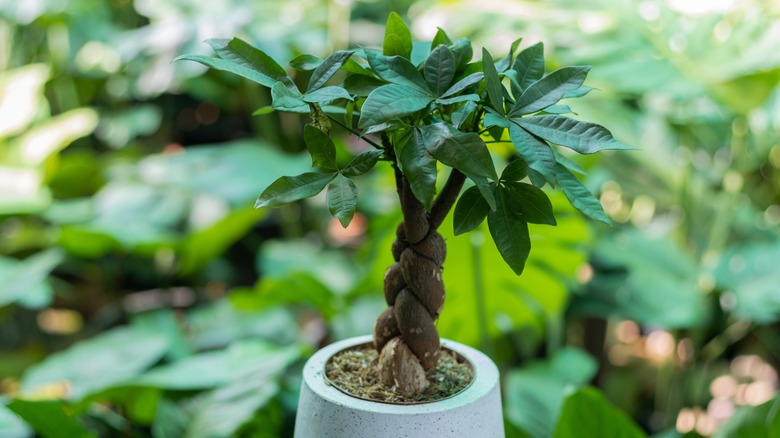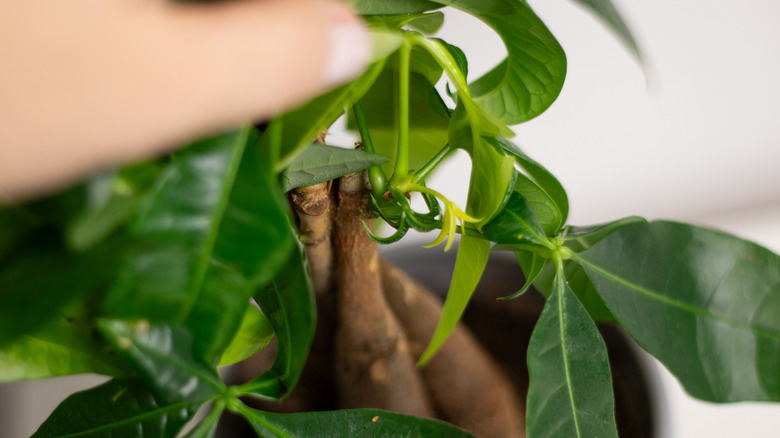How To Braid Your Money Tree (And Signs You're Doing It Wrong)
When it comes to houseplants, the money tree (Pachira aquatica) is a beautiful and popular choice. The attractive plant has braided stems and has long been regarded as a source of good luck and fortune. Money trees are not toxic to pets and are low-maintenance, making them a terrific houseplant that's easy to care for when you don't have a green thumb. One of the most exciting aspects of money trees is that you can braid their stems for added visual appeal. Money tree braiding is simple and is a process you can continue to enjoy over months or years, depending on how tall you want yours to be.
Braiding is incredibly simple, akin to braiding and then tying up hair. However, you'll need to remove the money tree from its pot before doing so and repot it afterward. The plant will need a semi-shady place to recover afterward, as well as regular care and maintenance. You should avoid braiding or tying it too tightly, as well as braiding mature stems, to avoid stressing it out.
The tree doesn't have to be braided to survive, but it can be just for aesthetics. It's a natively tropical plant, thriving in USDA hardiness zones 10 to 12. No matter where it's planted, though, it needs the right growing conditions, like indirect sunlight of medium to full brightness. The money tree also needs well-draining soil to avoid root rot, soil that is neutral to slightly acidic, with a pH of 6.0 to 7.5. As far as watering goes, it is used to humid environments, but it likes its soil to almost fully dry out in between waterings.
Safely braiding a money tree
The braiding process is easy enough for anyone to do, and there are a few things you can do to keep your plant safe and happy during the process. Supply-wise, you'll need only some flexible plant ties. Choose a plant with young, green, and undiseased stems. You can either buy loose money tree strands to braid together or unpot an unbraided plant to braid it. Remove any leafy branches on the lower stems that will block the braiding area before starting.
Braiding here works just like it does with hair in that you'll gently take the outermost stem from one side and move it to the innermost spot, then do the same from the other side until you've reached either the leaves or the stem bases (depending on which direction you choose to braid in). As you work, make sure the stems all lie fairly snug against one another but are not tight; this will create a secure braid that still allows the plants room to breathe and grow. When you're done, secure your braid near the leaves and base with adjustable ties, twine, or other means, and then repot it with well-draining soil, and lightly water it. Set your plant in a partially shady location for a few weeks while it recovers, and then move it to its regular home.
From here on out, it's just caring for your money tree. You can choose to continue braiding your money tree as it grows by simply repeating the process above. Over time, you'll see the stems at the base begin to fuse and thicken. The plant will also form a cork-like bark from the bottom up as it matures.
What not to do when braiding a money tree
Braiding a money tree is simple and rewarding, but there are a few no-no's to watch out for throughout the entire braiding process and when maintaining it afterward. Avoiding these will all but guarantee that your money tree is healthy, happy, and looks fantastic in your house.
The first is ensuring that you don't use any diseased or decaying stems. If your money tree has yellowing leaves or has a soggy-feeling stem, discard it. Likewise, you should not work with a stem that already has bark forming on it, as this means it is stiff and mature. Using it would likely crack it or stress it to the point that it would suffer and compromise the rest of the plant. While braiding, avoid making it overly tight. This will similarly stress the plant out.
Post-braiding, avoid rigid ties or tying your ties too tightly — money trees need flexible security that allows them to grow and adjust over time. You'll also want to ensure that you braid gently and don't force any stems at any point. Lastly, don't prune it in winter, as this will make the plant go into shock and possibly even stunt its overall growth. Braiding a money tree is a rewarding process you can enjoy and continue working on for years, so make sure your plant is happy.


